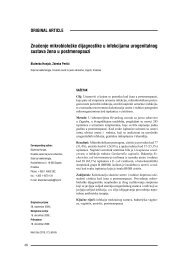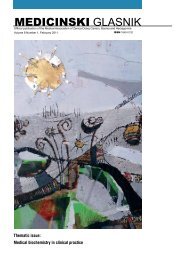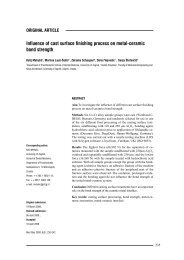Povijest i čimbenici preživljavanja umjetnog zgloba kuka
Povijest i čimbenici preživljavanja umjetnog zgloba kuka
Povijest i čimbenici preživljavanja umjetnog zgloba kuka
Create successful ePaper yourself
Turn your PDF publications into a flip-book with our unique Google optimized e-Paper software.
Biomechanical factors<br />
The level of physical activity and body mass<br />
index influence the forces that affect the endoprothesis,<br />
thus they are considered as biomechanical<br />
factors. Another potentially important<br />
factor would be the constructional one that is,<br />
the biomechanical features of the endoprothesis<br />
(26). A large number of endoprothetic models are<br />
available, that differ significantly with respect to<br />
constructional details. There is no data based on<br />
which one could conclude about potential differences<br />
in aseptic instability occurrence that would<br />
be attributable to the constructional features.<br />
There is also no data that would indicate that the<br />
surgical procedures that are sometimes necessary<br />
in addition to the endoprothesis implantation<br />
(acetabuloplasty or trochanter osteotomy),<br />
and which change the biomechanical situation<br />
of the hip joint, affect the occurrence of aseptic<br />
instability. On the other hand, the inclination angle<br />
of the acetabulum achieved at endoprothesis<br />
implantation significantly influences the occurrence<br />
of aseptic instability. Namely, the goal<br />
is to achieve an angle of 45 degrees, whereby a<br />
discrepancy of +/- 5 degrees is tolerated. Unfavorable<br />
inclination angle of the acetablumum<br />
due to a bad biomechanics of the joint itself, and<br />
consequently larger friction between the constituting<br />
part of the endoprothesis, increases the<br />
risk of aseptic instability (27, 28). Unfortunately,<br />
it has been shown that aseptic instability occurs<br />
also with a favorable inclination angle (40-50<br />
degrees) (19).<br />
Exceeding body mass (body mass index, BMI,<br />
>25 and particularly >30) is a classical factor<br />
that contributes to (over)burdening of the skeletal-muscular<br />
system, and also of the hip endoprothesis.<br />
However, the research of the influence<br />
of BMI on the occurrence of aseptic instability<br />
is related with certain problems. Namely, in this<br />
kind of research the outcome of interest is time<br />
elapsed until the occurrence of event (instability)<br />
and patients are followed-up for a long period<br />
of time (e.g., 10 years or longer). Data are<br />
typically analyzed with the assumption of the<br />
“constant hazard” - it is assumed that the risk<br />
associated with a certain factor is constant over<br />
time (for example, age at the time of surgery,<br />
type of endoprothesis, gender, disease leading<br />
to the need for endoprothesis, etc.). Body mass<br />
index can change significantly over time. In the<br />
literature, there is practically no study in which<br />
BMI has been considered as a time-dependent<br />
variable. It is therefore difficult to realistically<br />
assess the influence of this factor on the occurrence<br />
of aseptic instability. In a study conducted<br />
over a shorter period of time, body mass<br />
index >30 at the time of the implantation of endoprothesis<br />
was identified as a negative factor<br />
for the endoprothesis survival (29). It should be<br />
noted, however, that aseptic instability occurs<br />
also in patients with a permanent physiological<br />
body mass index.<br />
Other factors<br />
Kolundžić et al Total hip atroplasty<br />
Based on the analysis of around 54,000 endoprotheses<br />
from the Norwegian THA registry (30), the<br />
risk of aseptic instability is higher in patients<br />
with developmental hip anomalies than in those<br />
in which THA was indicated for other reasons<br />
(e.g., primary osteoarthritis, aseptic necrosis of<br />
the femoral head, injuries etc).<br />
Based on the analysis of around 32,000 endoprotheses<br />
(cemented and non-cemented) from<br />
the Norwegian THA registry (31, 32), more<br />
experienced surgeons (measured by a number of<br />
procedures annually) need less time for the implantation<br />
of endoprothesis than less experienced<br />
surgeons. Independent of the age and gender of a<br />
patient, the type of endoprohesis or disease that<br />
led to the need for endoprothesis, the risk of aseptic<br />
instability is higher in patients treated by less<br />
experienced surgeons. The risk of aseptic instability<br />
is greater if the operations last longer than the<br />
average of 90 minutes. Also, the risk is greater if<br />
the operation lasts shorter than 50 minutes.<br />
For quite some time, it has been a common opinion<br />
that there are “patient-dependent factors”,<br />
which are not demographic, (co)morbidity or biomechanical,<br />
that significantly determine the individual<br />
„inclination“ towards the development of<br />
aseptic instability of THA (33-35). Namely, large<br />
interindividual differences have been noticed in<br />
the intensity of the inflammatory process which<br />
results in aseptic instability for a given type of<br />
prothesis, for the amount of loose particles, demographic,<br />
(co)morbidity and biomechanical<br />
features and the „skill of the surgeon“. During<br />
the last 7-8 years, the concept has arisen which<br />
assumes that this „unexplained part of the indivi-<br />
139












